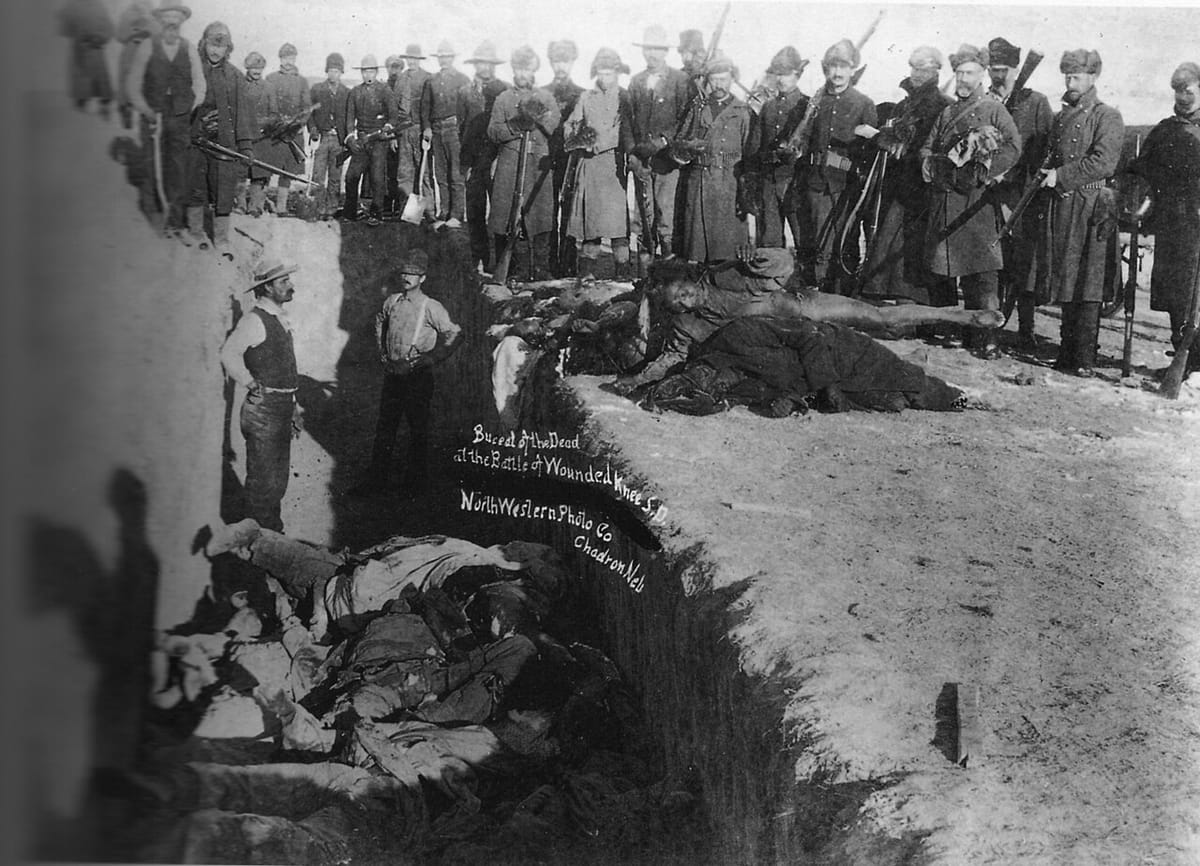The Pro-Massacre, Pro-Segregation, Pro-Eugenics Administration
The Trump administration is seeking to rewind the clock on an entire century of legal—and moral—progress.

Looking back 135 years later, the slaughter of hundreds of Lakota men, women and children by American soldiers at Wounded Knee Creek in South Dakota feels horrific, nightmarish, but tragically unsurprising.
The Native American population at the time was at an all-time low amid the continued loss of ancestral lands and widespread starvation at the hands of the U.S. government. Amid the misery came a religious revival called the Ghost Dance, which fused Indigenous beliefs with Christian themes, the promise of a homeland restored and, of course, dancing.
Unnerved by the sight of Natives less miserable than they were supposed to be, settlers and the U.S. military believed Ghost Dance adherents were working themselves up into a frenzied uprising. One federal agent, oblivious to his own absurdity, wrote to his superiors that “nothing short of one thousand soldiers will settle this dancing.”
Within weeks, five times that number had arrived. Rumors flew in both directions that one side was about to attack the other. Police in the area killed the well-known Chief Sitting Bull during his attempted arrest. And shortly before the end of 1890, American cavalry surrounded an encampment of several hundred Lakota whom Sitting Bull’s half-brother was trying to lead to safety.
A gunshot rang out from somewhere, and months of tension exploded in fire and metal. Twenty-five soldiers were killed, mostly from friendly fire, and their comrades killed more than 10 times as many Lakota of all ages. Scattered bodies—unarmed adults and children that our country’s soldiers pursued and murdered—were eventually buried in a mass grave.
Several of those soldiers received the highest military honor, the Medal of Honor, for their butchery. But even Maj. Gen. Nelson A. Miles, who had fought Native forces for decades and himself ordered many of the troops to the area, later wrote, “I have never heard of a more brutal, cold-blooded massacre than that at Wounded Knee.”
American society, excruciatingly slowly, came to agree on the evil of that day. Congress apologized for Wounded Knee in 1990, sounding downright woke when it called for “a more enlightened policy of Indian self-determination and respect for human rights.” There has been bipartisan talk since then of partnering with the victims’ descendants on some kind of official monument at the site, including a bill introduced in Congress this year.
But in late September, Secretary of Defense Pete Hegseth decided the massacre was pretty great, actually.
“We’re making it clear that they deserve those medals,” he said in a Sept. 25 video announcing his decision not to revoke the military honors for the perpetrators. "We salute their memory, we honor their service, and we will never forget what they did.”
The decision is an indecent outrage all on its own. But it also illustrates a broader project that’s been building since day 1 of Trump's second term: not just to undo the work of Donald Trump’s predecessors, which he has certainly tried, but to rewind the clock on an entire century of legal—and moral—progress.
Put another way, we’re no longer in the usual realm of Republicans whitewashing or downplaying the darkness in our history, e.g., the Supreme Court saying we don’t need voting protections because racism isn’t so bad anymore. This administration has upgraded the earlier model, showing through word and action that it believes the shameful sides of America’s past were, in fact, good—even examples to follow today.
Take civil rights, particularly the decades-long, organized push to end Jim Crow discrimination in voting, housing, schooling and other legal arenas half a century ago. Trump et al. are dismantling its legacy piece by piece:
- In his first week back in office, Trump froze the Department of Justice’s pursuit of civil rights cases, including police reform agreements that followed officers’ killings of George Floyd and Breonna Taylor.
- Also in the first week, Trump rescinded a 60-year-old executive order that banned racial and other discrimination in federal employment—one that was published by Lyndon B. Johnson just weeks after he signed the Voting Rights Act of 1965.
- In February, Trump fired the Black chairman of the Joint Chiefs of Staff, whom Hegseth pretends was hired only because of his race. Hegseth also proclaimed that “the single dumbest phrase in military history is ‘our diversity is our strength.’” It fits a broad pattern of removing Black leaders throughout the government and replacing them with white ones.
- In July, Attorney General Pam Bondi advised schools that essentially any deliberate effort to diversify their student bodies—not just considering race but also any factor, like income, that might correlate to race—would be considered illegal.
- In August, Trump declared the Smithsonian and other museums focused too much on “how bad Slavery was.”
- And in September, The New York Times reported that fair housing protections, which say you can’t block people from your apartments and houses because they’re a certain color (as Trump knows from personal experience), are being rolled back and ignored.
These are not the actions of a government that believes the right side triumphed in the Civil Rights Movement, that people of all skin colors belong in all spheres of public life, or that race doesn’t define one’s ability or worth. As Adam Serwer observed in February, we are in the midst of a “Great Resegregation.”
Our societal regression extends to public health as well. As the concepts of natural selection and survival of the fittest entered popular culture a century ago, they sprouted the eugenics movement. Eugenics was the high-society term for the idea that we should breed better humans and that worse humans—which usually meant poor, ill or darker-skinned—shouldn’t breed at all.
States sterilized tens of thousands of people, including one woman who gave birth out of wedlock and whose 1927 court case ended when Justice Oliver Wendell Holmes declared that “three generations of imbeciles is enough.” The New England Journal of Medicine in 1934 praised Nazi Germany as “perhaps the most progressive nation in restricting fecundity among the unfit.”
The field of medicine, and society writ large, thankfully rejected eugenics after World War II and the Holocaust showed exactly where this line of thinking ends. Instead of abandoning the sick or hurt as a necessary loss and culling the “weak,” we try to prevent, treat, accommodate, understand and cure disability and disease. None of us are immune to those things, and people in all conditions have worth and can lead meaningful lives.
This administration likes the old approach better. Our president has long shared his love for “good genes,” and his nephew last year alleged that Trump said disabled people “should just die” and save the rest of us the money and effort. And he has a Health and Human Services secretary to match in Robert F. Kennedy, Jr.
RFK made headlines this spring when he said poultry farmers should let bird flu run wild and kill lots of birds because the strong will survive. (Never mind that the disease is nearly always fatal, and letting a virus run rampant is a good way for it to mutate its way around any immunity, as we saw with Covid-19). He has since demonstrated similar feelings about humans, dragging his feet on measles outbreaks, undermining vaccinations at every turn and expressing an abiding interest in “superior genetics,” according to Demetre Daskalakis, the former National Center for Immunization and Respiratory Diseases director who resigned in August.
And we cannot forget Elon Musk and DOGE’s destruction of USAID, which has probably killed hundreds of thousands of the world’s poorest people and could kill millions—millions—more. “The picture of the world’s richest man killing the world’s poorest children is not a pretty one,” Bill Gates said, in massive understatement, in May. These are not the actions of an administration that wants to save as many people as possible. This administration wants something else.
What do we do in the face of a pro-massacre, pro-segregation, pro-eugenics government? I have a few suggestions.
First, we can hold onto our essential moral beliefs regardless of federal reversions: The progress of the last century was correct and good, and the job isn’t finished. The same old brawls continue, and we must stay in the fight.
Second, we can judge our representatives and other public figures by their response or lack thereof: Are they complicit in this monstrousness? Are they trying to tell us to focus on something else or to find common ground with it? Or are they calling it out as it deserves?
Finally, we can learn an important lesson from how this all happened. When you decide that America must be 100% right and good at all times, that everything it has done must have been justifiable, then you will find yourself celebrating inhumanity. I choose instead to see the injustices as well as their targets: the communities that have pushed my home, slowly, to be better.
Featured image is a mass grave at Wounded Knee




